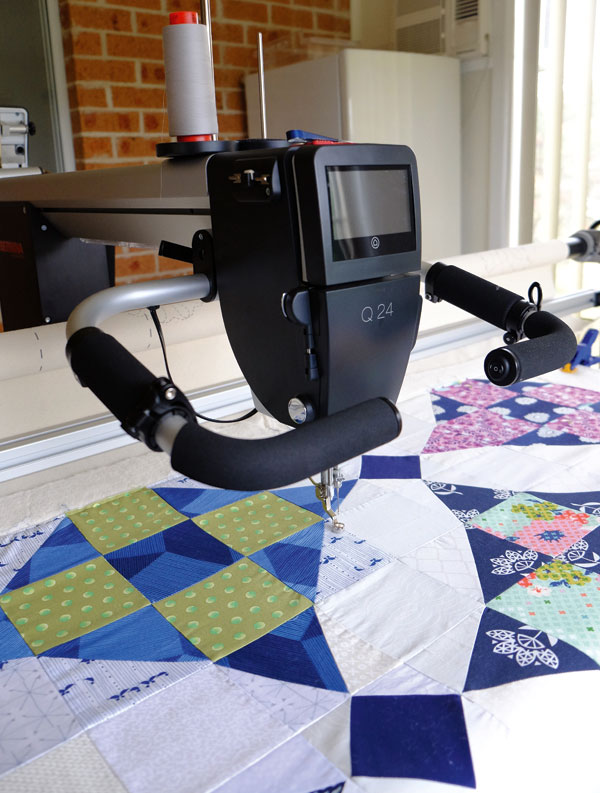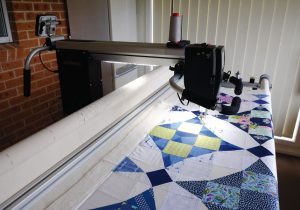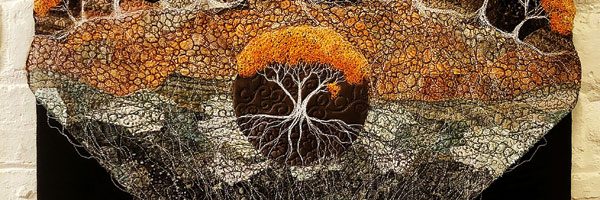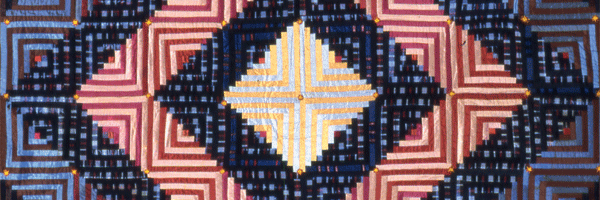
Road Test: Bernina Q24
Driven by Michelle Marvig
Buying a sewing machine today is not a simple task. There are so many features, functions and accessories. If you want to quilt big and can accommodate a long arm machine, there are many on the market. Recently my husband purchased a Bernina Q24. Yes ladies, he does quilt!
So what is a Q24? It is the biggest machine in the Bernina range. It has a throat space of 24in, measured from the body of the machine to the needle. However, with space needed to clear rollers, the width available to stitch is closer to 19in. The same restraints are on all long arm machines as they work in a similar manner.
The sewing machine is a separate item to the frame on which it is mounted. Bernina has three extruded aluminium frame sizes available for the Q20 (same machine but with a throat space of 20in, which can be table-mounted) and Q24. The size you choose will depend on space, and the larger the frame, the bigger the quilt you can work on in a single load.
The Classic is the middle size, measuring 3.6 long and 1.2 wide. It has a flat bed at the back, with multiple bars and rollers to hold the different layers of the quilt. Having said that, you have so many accessories to choose from to customise your frame. Each has a cost involved. Casters, additional shelving, batting roll holders and even hydraulic height control are frame options. The leaders, or heavy fabric that the quilts are pinned to, are included in the initial cost of the frame. The frame comes in many boxes and needs to be assembled. You can negotiate this with your dealer, although a manual for construction does come with the frame.
The actual sewing machine is mounted onto a base carriage that has two sets of rollers. One set runs along the two horizontal tracks on the flat, wide section located along the back of the frame. This allows for the left and right movement. The second set of rollers is placed at right angles under the machine on the base carriage to allow for movement front to back. One set of adjustable, ergonomic front handles is included in the initial cost. To make the most of working from this side of the machine you will also find the Ruler Kit handy, with a Perspex base to support the ruler, a foot designed to run along the edge of the ruler and one ruler to get you started.
If you wish to use a paper pantograph for edge-to-edge quilting you will need to purchase the Pantograph Kit, which comes with extra handles for the back of the machine, second computer display, laser light, stylus and holder, and a detached heavy piece of plastic to hold the paper pantograph in place. Pantographs can also be completed by computer and the Bernina Q-matic is the automated quilting solution for the Q24. It is an optional extra cost.
Now how does all this run? Let me just say upfront that we did own a Gammill long arm machine for almost 20 years and it came with electronic Channel Locks. As part of our optional extras we had to purchase mechanical Channel Locks for our Bernina Q24. We use Channel Locks to baste the layers of the quilt together, to stitch straight, vertical and horizontal lines. They are a critical part of the quilting on a long arm machine. If you have the Q-matic computer system, the Channel Lock is part of this system and you do not require the mechanical Channel Locks. As we do not have the computer system on this machine, we need to reach around the bulk of the quilt and machine to access and use the Channel Locks located on the frame of the carriage. Previously on our other machine it was a simple touch of a button on the front or back of the machine, and this enabled Channel Locking on the fly. The Bernina Q24 machine is updateable and hopefully the fact that there is a symbol for Channel Lock on the back of the machine means it will be a simple push of a button one day.
In some ways this machine is similar to a ‘normal’ Bernina. The presser feet are interchangeable and use the same mechanism as their other machines. This does allow for greater flexibility of choice. The bobbin winder has a separate motor and mechanism, so you do not need to unthread the machine to wind a bobbin. Also, normal sewing needles are used is this machine, not commercial needles.
The computer screen on the machine is where you set up the machine to stitch. Just as on other Berninas, this machine has stitch regulation. In this case, two BSR units are located under the plate of the machine in the bobbin area. These units allow you to change the number of stitches per inch, keeping the length even and giving an audible alert if you go too fast for the BSR units. Three different BSR modes are offered, plus you can turn it off and work manually if you prefer.
On the bottom of the screen there are four programmable function buttons. These relate to the buttons on the handles, which is how you operate the machine. You can choose which function you prefer on which button: needle up/down, start/stop, securing, presser foot up/down or even increasing or reducing speed. You can also save your favourite settings for multiple people and the machine will adjust to the user’s preferences.
The quality of the stitching is excellent. You can adjust machine tension easily on screen, so using different threads on the top and bottom is not an issue. The lightness of the machine makes it easier to move and execute the quilting stitch. The stitch length adjustment allows us to baste a quilt with long stitches, or do fine micro stippling if you fancy.
There are a few minor issues that we have had to address. When the first quilt was unloaded from the leaders, we put the pins on the back table as we have done previously. They fell down between the base of the table and the frame. We have placed a strip of angled plastic along here now to stop the loss of the pins. Also, we changed the side clamps as those included on the frame as standard kept flicking off when under tension.
The lack of a handle on the backing rail is an issue when you have a maximum-size quilt on the frame. You need to manually turn the roller by grabbing it with your hand, but there is not much room. Also, the tension of the batting and quilt front makes it heavy. The detached plastic sheet for the paper pantograph is loose, allowing for the pattern to move while you are working. The width of the plastic does not cover all widths of pantograph areas. We have chosen to stick down the plastic to avoid movement issues.
Which new sewing or quilting machine you choose is a very personal one. Locate your local Bernina dealer and test drive a Bernina long arm machine. You can then customise it to your own personal needs.



